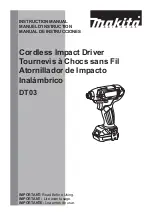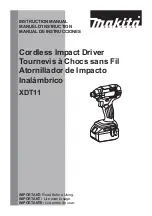
Do not operate charger if it has received
a sharp blow, been dropped or otherwise
damaged in any way. Have a qualified
technician examine the charger and
repair it if necessary. Do not
disassemble the charger.
For best results, do not charge the
battery when the battery or air
temperature is below 50
o
F (10
o
C) or
above 105
o
F (40
o
C).
Unplug the charger when not in use and
before cleaning or maintenance.
Do not abuse the cord. To reduce the
risk of damage to the electric cord or
plug, never carry the charger by the cord
or yank the cord to pull the plug. Always
grasp the plug and pull to disconnect.
Always keep the cord away from heat, oil
and sharp edges.
Some of the following symbols may be
used on your tool. Please study them and
learn their meaning. Proper interpretation
of these symbols will allow you to operate
the tool better and safer.
V
volts
A
amperes
Hz
hertz
W
watt
Kw
kilowatts
F
farads
microfarads
l
litres
Kg
kilograms
bar
bars
Pa
pascals
h
Hours
min
minutes
s
seconds
No load speed
./min or
min¯¹
Revolutions or
reciprocations per minute
direct current
alternating current
²
two-phase alternating
current
2N
two-phase alternating
current with neutral
three-phase alternating
current
3N
three-phase alternating
current with neutral
Rated current of the
appropriate fuse-link in
amperes
Time-lag miniature fuse-
link where X is the
symbol for the
time/current
characteristic, as given in
EN 60127
protective earthing at
earthing terminal, Class I
tools
Diameter
Off position
Arrow
Warning symbol
alternating or direct
current
splash proof construction
watertight construction
class II construction
IPXX
IP symbol
BATTERY & CHARGER
SAFETY
SAVE THESE INSTRUCTIONS FOR REFERENCE
7
SYMBOLS
WARNING
!
SYMBOLS


































